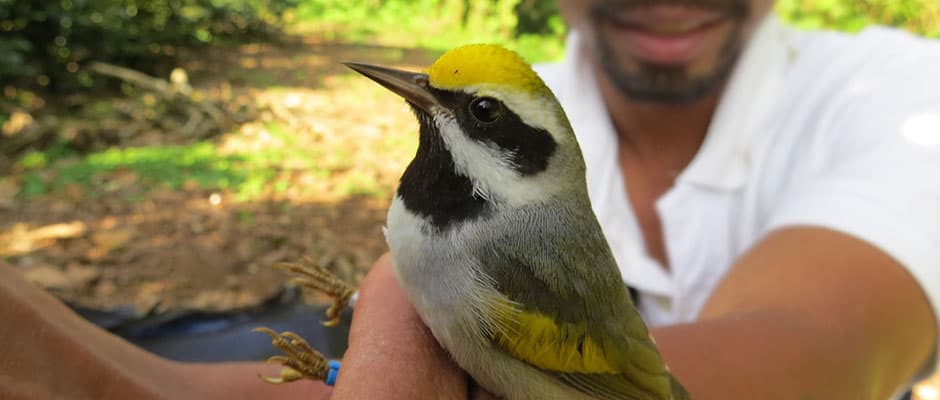Share this article
Luck Connects Research Bird from Illinois to Nicaragua
Nobody knew precisely where it came from, and it didn’t have a particularly remarkable name when researchers first discovered it in September 2014 in the Seversen Dells Nature Preserve in northern Illinois.
But golden-winged warbler (Vermivora chrysoptera) number 2680-13793 was captured along with several other species of birds early in their journey from the Great Lakes region down to their wintering grounds in Latin America.
The bird, who we’ll call “Two” for short, was given a colored band with a number by Rockford University researcher James Marshall, who was looking to see whether the warblers and other migrant birds had a hand (or a wing) in spreading invasive bush honeysuckles.
“He probably didn’t think anything of it,” said Amber Roth — a research assistant professor at Michigan Technological University. He put a band on Two and “sent it on its merry way.”
Sometime later and after a rather large journey that took Two across the U.S. from north to south and likely included a deadheaded barrel across the Gulf of Mexico, the golden-winged warbler ended up on a coffee plantation in Nicaragua where it presumably intended to spend a relaxing winter.
But Two apparently hadn’t learned its lesson back in Seversen Dells and on January 25 of this year in the Central American plantation, the bird was captured once more by Roth.
Whether it was planned or not, Two had happened to break from the winter in the world’s first nature preserve built for golden-winged warblers — The Jaguar Reserve. “It’s like he read the flyer,” Roth said of Two arriving at the coffee plantation that sits in a cloud forest which had set aside an adjacent property for the birds.
Roth was conducting a couple of studies there — one which looked at the annual survival of the warblers in their wintering grounds, and another which attempted to see how many of the warblers survived their migratory return to Illinois. She and her team were using recorded warbler sounds played back to attract the birds before netting them right on the edge of the coffee and the jungle.
But since many birds in the area had been banded by her team already, she didn’t realize where Two had earned his stripes yet. “The prefix happened to be the same prefix that I used,” she said, but it was a coincidence. They checked the numbers with people around them, and the “excitement was gradually building” as they eliminated other possibilities. But when they discovered it came from Marshall’s study, they realized they had a bird that acted as a proxy for Kevin Bacon for the research world. “This one little bird has connected so many different projects,” she said. “He’s probably the most studied golden-winged warbler ever.
But nonetheless she’s hoping Two will perform a research hat trick and that someone will find him once more in the Nicaraguan wintering grounds. The bird now has been equipped with a geolocator as part of an effort to find where the birds fly exactly on their migration route.
The golden-winged warbler is currently under review for protection under the Endangered Species Act, and Roth said it’s suspected the birds could be suffering from climate change-induced problems while crossing the Gulf of Mexico as well as the loss of shoreline habitat along the U.S. Gulf Coast when they arrive after their long airborne haul. The information about where they go exactly is critical because it could give researchers a better idea of these kinds of threats on the birds’ journeys back north.
Roth said it’s possible that Two will be found. As opposed to blackpoll warblers (Setophaga striata), whose migration routes were uncertain until recently, Roth said that golden-winged warblers have about a 50 percent return rate for researchers — it’s easier to find them because they are quite territorial on both their summer and wintering grounds.
But while Two has brought researchers a serendipitous finding already, she still acknowledges that to find him once more in the north, “we’re going to need some luck.”
Listen to an audio recording of a golden-winged warbler.
Header Image:
Moises Siles, Amber Roth’s banding assistant at Reserva El Jaguar in Nicaragua, holds golden-winged warbler #2680-13793 in his hand. The bird was banded in Illinois and discovered by chance in the Central American country.
Image credit: Amber Roth








